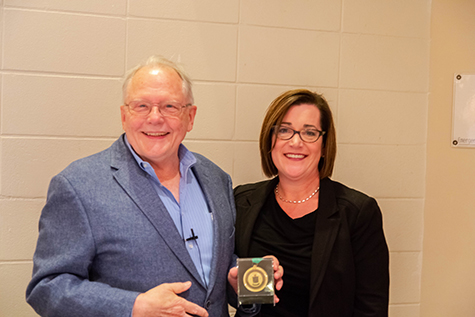The 20th Springer Award Honoree, Dr. Thomas Norton, professor emeritus, presented a lecture entitled "Toward Myopia Control: from animal models to children—the UAB connection" to students, faculty, and alumni on October 25th. In the lecture, Dr. Norton described research from his lab that began over three decades ago and is part of the foundation for the myopia treatments used today at the UAB School of Optometry.
“I chose this topic because it shows how basic research in animals has led to clinical studies in children and to the development of treatments aimed at slowing the development of myopia in children,” Norton said. “I felt this story would be of interest to the students.”
Norton has authored or co-authored more than 90 journal articles and has presented abstracts at vision meetings almost yearly since 1975. He has presented about 150 invited lecturers at major meetings, congresses, and universities in North America, Europe, and Asia. He received his undergraduate degree in psychology from Yale University in 1965 and earned a Ph.D. in psychology from the University of California, Los Angeles, in 1970. After post-doctoral work at the University of Pennsylvania School of Medicine, he spent six years at Duke University where he and his colleagues discovered the tree shrew model of refractive error (myopia).
From the time he came to the UAB School of Optometry in 1978 until his retirement in 2013, Dr. Norton and his students studied the postnatal development of refractive error. Their research was funded by the National Eye Institute. Now retired, Dr. Norton works part-time as a consultant with Dr. Tim Gawne in the Department of Optometry and Vision Science.
One of the most important discoveries, to which Norton’s lab made important contributions, is that there is a feedback mechanism, called an emmetropization mechanism, that guides eyes to become emmetropic (in good focus). This mechanism uses defocus (how out of focus images are on the retina) to adjust the eye’s growth so that defocus is reduced and images come to be clearly focused on the retina (the light-detecting area at the back of the eye). Norton’s team studied how cells (neurons) in the retina generate guidance signals that travel to the sclera (the outer shell of the eyeball) to adjust the growth of the eye.
Dr. Kathy Weise, UABSO professor and Director of the Pediatric Service, considers Norton to be her academic grandfather.
“Clinical optometry wouldn't be the same without Dr. Norton's work in animal and vision science,” Weise said. “Dr. Norton shaped my career, yes, but more importantly shaped the way we have treated our patients for the last 20 years. And, he laid the cornerstone in the foundation for our clinical future in patient care. For me, Dr. Norton is the Steve Jobs of myopia.”
When asked about being the Springer Award Honoree, Dr. Norton said: “I am very honored to have the opportunity to present an important story that is meaningful both to scientists and clinicians at UAB.”
About the Springer Lecture
The lecture is supported by the Nathaniel E. Springer Memorial Fund, which was established in 1999 to bring distinguished visual scientists or clinicians to the School of Optometry to share knowledge with faculty and students.
The fund was created by Donald Springer, O.D., who was instrumental in the founding of the School of Optometry and a leader in optometry in Alabama and the U.S. along with other members of the Springer family, in memory of Springer’s father Nathaniel E. Springer. Donald Springer died in 2011.
